


This article highlights the essential medications that play a crucial role in effectively treating Deep Vein Thrombosis (DVT). Understanding your options is important, and medications such as:
are among those that can help manage this condition effectively. Each of these medications has its own efficacy and safety profile, and it’s vital to consider them in the context of your individual health needs.
Furthermore, patient education and monitoring are key components in ensuring that treatment outcomes are optimal. It’s natural to have questions and concerns about your health, and being informed can empower you to make the best decisions for your well-being. Remember, you are not alone in this journey; support is available, and seeking help is a sign of strength. Together, we can navigate the path to better health.
Facing the challenges of Deep Vein Thrombosis (DVT) can feel overwhelming. It's natural to have concerns about your health. Understanding the array of treatment options available can empower you to make informed health decisions. In this article, we will explore ten essential medications and therapies that play a pivotal role in effectively managing DVT. We aim to provide insights into their benefits and potential side effects, helping you feel more at ease with your choices.
As advancements in medical research continue to shape treatment protocols, you may wonder which of these options will best suit your unique needs on your journey toward recovery. Remember, you are not alone in this. There is support available, and we are here to help guide you through the process.
At Amavita Heart and Vascular Health, we understand that facing Deep Vein Thrombosis (DVT) can be daunting. That's why we emphasize a holistic approach to treatment, incorporating DVT meds along with minimally invasive procedures and personalized supportive care. Our goal is to improve the quality of life for those we serve, ensuring that you receive the most effective and empathetic assistance available.
We prioritize your education, empowering you to comprehend your and make informed decisions about your health. In addition to this, our dedication to comprehensive care not only addresses your immediate needs but also fosters long-term health and wellness through continuous support and education. We are here to walk alongside you on this journey, providing the reassurance and understanding you deserve.
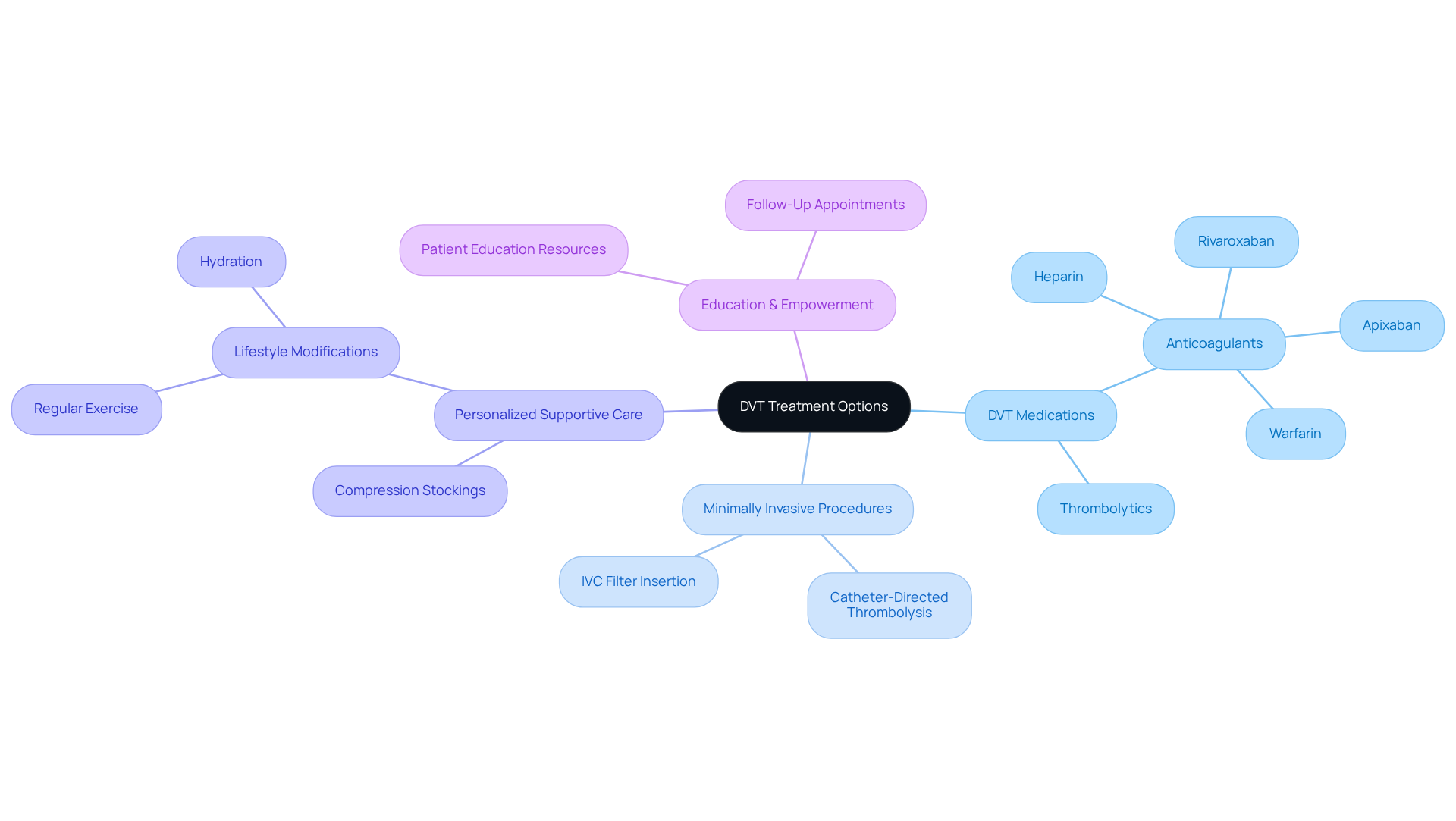
Rivaroxaban is a prominent oral anticoagulant that inhibits Factor Xa, a crucial element in the blood clotting cascade. As of 2025, the usage rates of DVT meds in managing deep vein thrombosis (DVT) have surged, reflecting their growing acceptance among healthcare providers. This medication, considered one of the preferred DVT meds, is particularly favored for its once-daily dosing regimen, which enhances adherence and removes the need for routine blood monitoring, making it an appealing choice for many individuals, especially the elderly.
Have you ever felt overwhelmed by the complexities of managing your health? Real-world studies have demonstrated the effectiveness of Rivaroxaban, a type of DVT meds, in preventing DVT recurrence, providing hope for many. For example, an extensive research involving almost 5,000 individuals suggested that those who persisted with Rivaroxaban for up to one year encountered notably reduced rates of recurrent venous thromboembolism (VTE) in comparison to those who stopped care after three months. Specifically, at three months, recurrent VTE occurred in 0.57% of the continued cohort and 1.19% in the discontinued cohort. This finding aligns with the recommendations of hematologists, who advocate for the use of oral anticoagulants like Rivaroxaban due to their favorable safety profile and ease of use. Dr. Scott Kaatz, the principal study investigator, stated, "This study in a broad real-world setting supports the ACCP guidelines for the extended management of an unprovoked VTE."
Furthermore, the convenience of Rivaroxaban's dosing schedule, combined with its proven efficacy, positions it as a leading choice among DVT meds for elderly patients managing DVT. The DVT meds not only simplify care routines but also play a vital role in enhancing the quality of life for those affected by this condition. With VTE impacting over 900,000 Americans annually, such as Rivaroxaban are essential. Older individuals are encouraged to consult their healthcare providers regarding their treatment options and to follow prescribed regimens. Remember, you are not alone in this journey; support is available to help you maximize the benefits of this medication.

Apixaban is an oral anticoagulant that selectively inhibits Factor Xa, much like Rivaroxaban. It is recognized for its effectiveness in reducing the risk of recurrence when using DVT meds. Many individuals appreciate its twice-daily dosing plan, which enhances convenience and aligns with their daily routines. Importantly, Apixaban boasts a favorable safety profile, significantly lowering the risk of major bleeding compared to traditional anticoagulants like Warfarin. This quality makes it a suitable choice for many, especially for those who may be at a higher risk for bleeding complications.
In a comparative study involving over 36,000 individuals with venous thromboembolism (VTE), Apixaban demonstrated superior outcomes, showing lower rates of recurrent DVT and bleeding incidents compared to Rivaroxaban. Specifically, the study concluded that those starting Apixaban experienced fewer recurrent VTE and bleeding events, reinforcing its position as a first-line therapy for acute DVT treatment. Cardiologists have noted that using Apixaban is linked to a reduced risk of intracranial or gastrointestinal bleeding. Dr. Geoffrey D. Barnes emphasized this by stating, "Use of apixaban was associated with a lower risk of intracranial or gastrointestinal bleeding as compared to rivaroxaban therapy."
The real-world effectiveness of Apixaban is also noteworthy, as it has been shown to successfully prevent DVT recurrence across various patient groups. This combination of efficacy and safety makes Apixaban an for managing DVT, aligning with the latest clinical insights and individual needs. If you or a loved one have concerns about DVT and anticoagulation therapy, consider discussing DVT meds, such as Apixaban, with your healthcare provider to explore if it's the right choice for you.
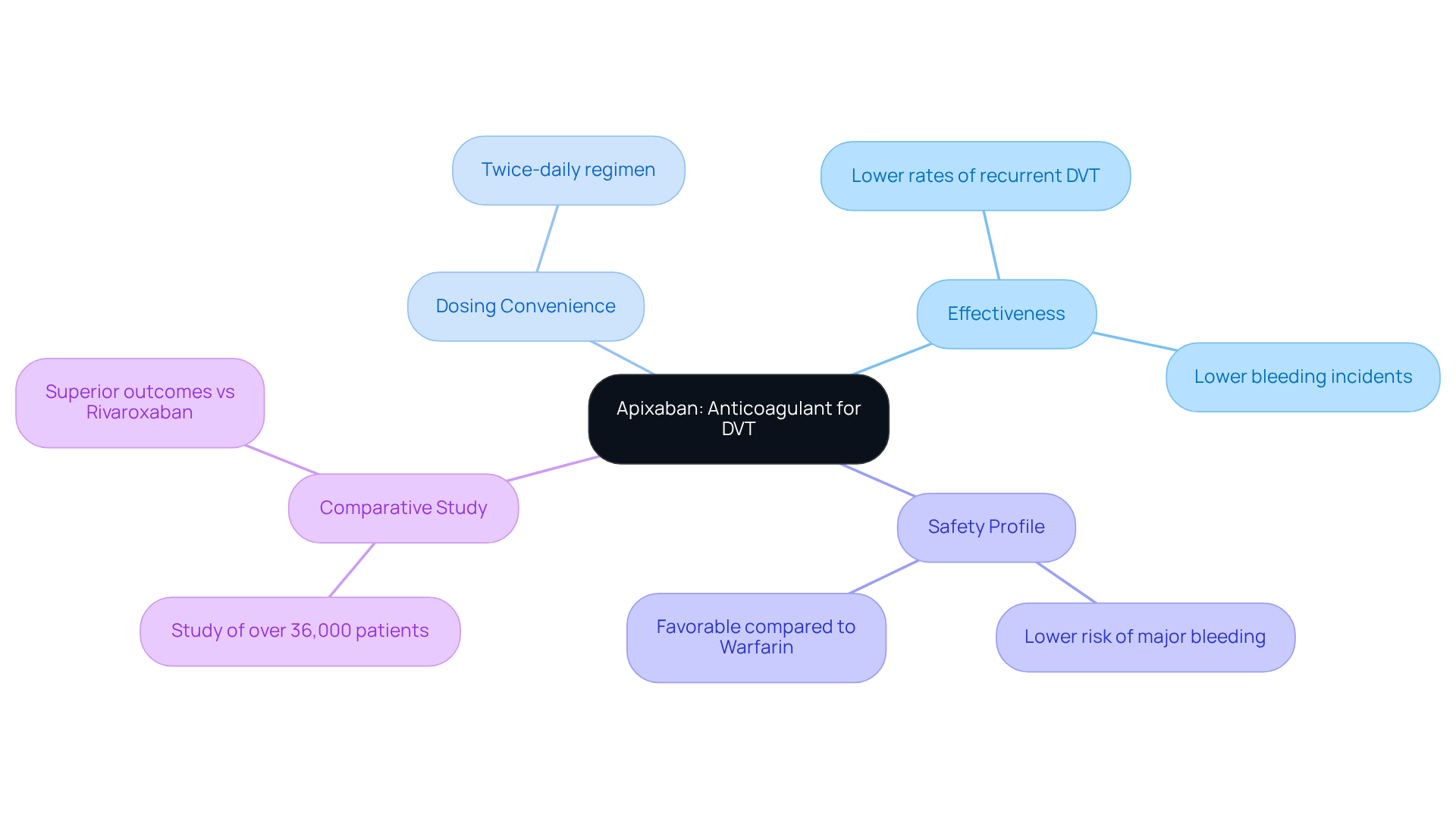
Dabigatran is a direct thrombin inhibitor that plays a crucial role in preventing the formation of fibrin, a key component in blood clot development. This medication, classified as one of the DVT meds, is taken orally twice a day and is particularly beneficial for treating deep vein thrombosis (DVT). Its rapid onset of action means that it can provide prompt anticoagulation, which is essential for individuals who need immediate relief from thrombotic events.
However, it’s important to stay informed about potential gastrointestinal side effects, which can occur in a considerable percentage of users. Being aware of these possibilities allows you to manage your health better. Adhering to the prescribed dosing schedule is vital, as it maximizes the medication's efficacy and minimizes complications. Vascular specialists emphasize that while Dabigatran offers significant benefits, are key to achieving the best results, especially for older populations who may be more susceptible to side effects.
Recent findings indicate that, despite these challenges, Dabigatran has shown favorable outcomes in elderly patients who are on DVT meds. This reinforces its role as a valuable option in anticoagulation therapy. Additionally, individualized management strategies that consider both thromboembolic and bleeding risks are essential for achieving the best possible results. Remember, you are not alone in this journey; seeking guidance and support can make a meaningful difference in your health and well-being.
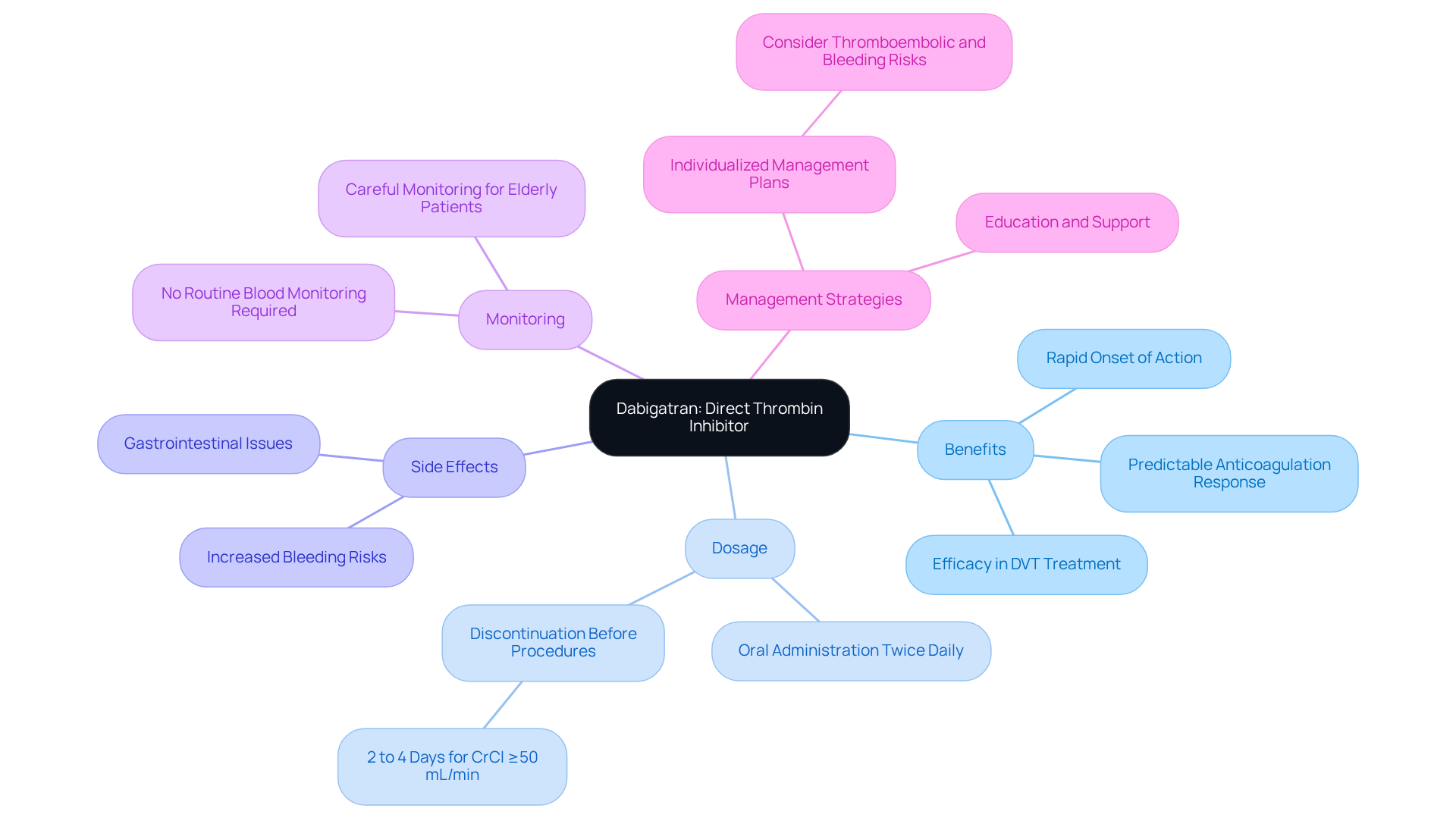
Heparin is a vital part of managing deep venous thrombosis (DVT) in hospital settings and is one of the key [DVT meds](https://amavita.health) that provides rapid anticoagulation through intravenous or subcutaneous administration. It’s important to monitor its effectiveness using activated partial thromboplastin time (aPTT), ensuring that therapeutic levels are consistently achieved.
This monitoring plays a crucial role in balancing the benefits of anticoagulation with the potential risk of bleeding complications, which can occur in 3-10% of individuals receiving care for 3-6 months. Hospitalists highlight the significance of this careful management, recognizing that while Heparin is effective, it requires attentive oversight to prevent any adverse effects.
Real-world experiences show that patients on Heparin therapy are closely monitored, with adjustments made based on aPTT results to ensure optimal dosing. This proactive approach not only enhances safety for patients but also through the use of DVT meds.
Remember, you are not alone in this journey; there are dedicated healthcare professionals ready to support you every step of the way.

If you or a loved one are dealing with concerns about deep vein thrombosis (DVT), it’s important to know that there are effective DVT meds available. Fondaparinux is a synthetic anticoagulant that selectively inhibits Factor Xa, making it one of the DVT meds similar to Rivaroxaban and Apixaban. This medication is administered through a simple subcutaneous injection and is often used for individuals who may be at risk of bleeding.
One of the great advantages of fondaparinux is its predictable pharmacokinetic profile. This means that it allows for fixed dosing without the need for routine monitoring, making it a convenient option for many patients. We understand that can be overwhelming, but rest assured, fondaparinux is designed to help you feel more secure in your treatment journey.
If you have questions or concerns about starting fondaparinux, please don’t hesitate to reach out to your healthcare provider. They are there to support you and guide you through this process, ensuring that you receive the care you deserve. Remember, you are not alone in this, and there are options available to help you on your path to better health.
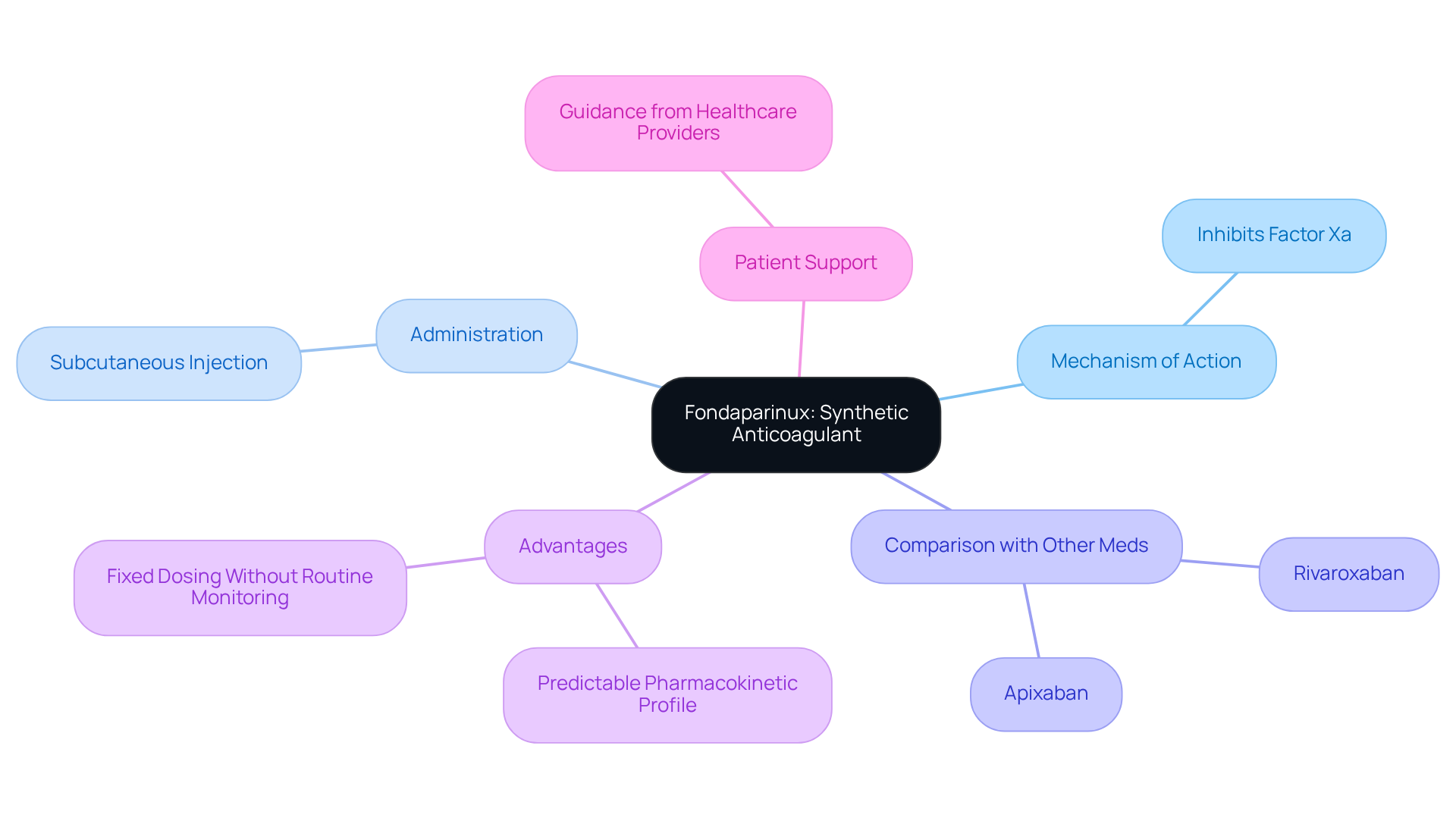
Warfarin is a cornerstone used among DVT meds for the long-term management of deep vein thrombosis (DVT). By inhibiting vitamin K-dependent clotting factors, it effectively lowers the likelihood of thromboembolic events. However, using Warfarin requires diligent monitoring of International Normalized Ratio (INR) levels to maintain therapeutic dosing and minimize bleeding risks. Research shows that compliance with INR monitoring is essential. Individuals who consistently check their INR achieve improved results and experience fewer complications. Specifically, INR should be measured daily for the first five days after starting Warfarin to ensure proper dosing.
Older individuals, in particular, encounter unique challenges with Warfarin due to its interactions with various foods and medications. Patient education is vital; understanding dietary restrictions and potential drug interactions can significantly enhance treatment efficacy. For example, hematologists stress that "educating individuals before starting Warfarin about signs and symptoms of bleeding, the effects of diet, and possible drug interactions is crucial for effective use."
Despite the emergence of newer anticoagulants, Warfarin remains essential for individuals with specific medical conditions, such as those with prosthetic heart valves or antiphospholipid syndrome. Recent studies have indicated that while Warfarin has a greater chance of bleeding compared to direct oral anticoagulants, it is more effective in these situations. Elevated INRs between 4.5 and 10 can be managed by withholding Warfarin and monitoring the INR if not associated with bleeding. Therefore, the choice to begin Warfarin treatment should rely on a comprehensive evaluation of each individual's medical history and risk factors, including the CHADS score, which aids in assessing stroke risk in individuals with atrial fibrillation.
Additionally, the age-adjusted Warfarin loading protocol recommends a 10 mg starting dose for individuals aged 50 years and under, decreasing to 6 mg for those over 80 years old, addressing the unique considerations for elderly individuals.
In summary, while Warfarin is a powerful tool in DVT management, its effectiveness relies on regular INR monitoring and thorough education for individuals using DVT meds. Patients should be proactive in their treatment by consistently checking their INR levels and discussing any concerns with their healthcare provider.
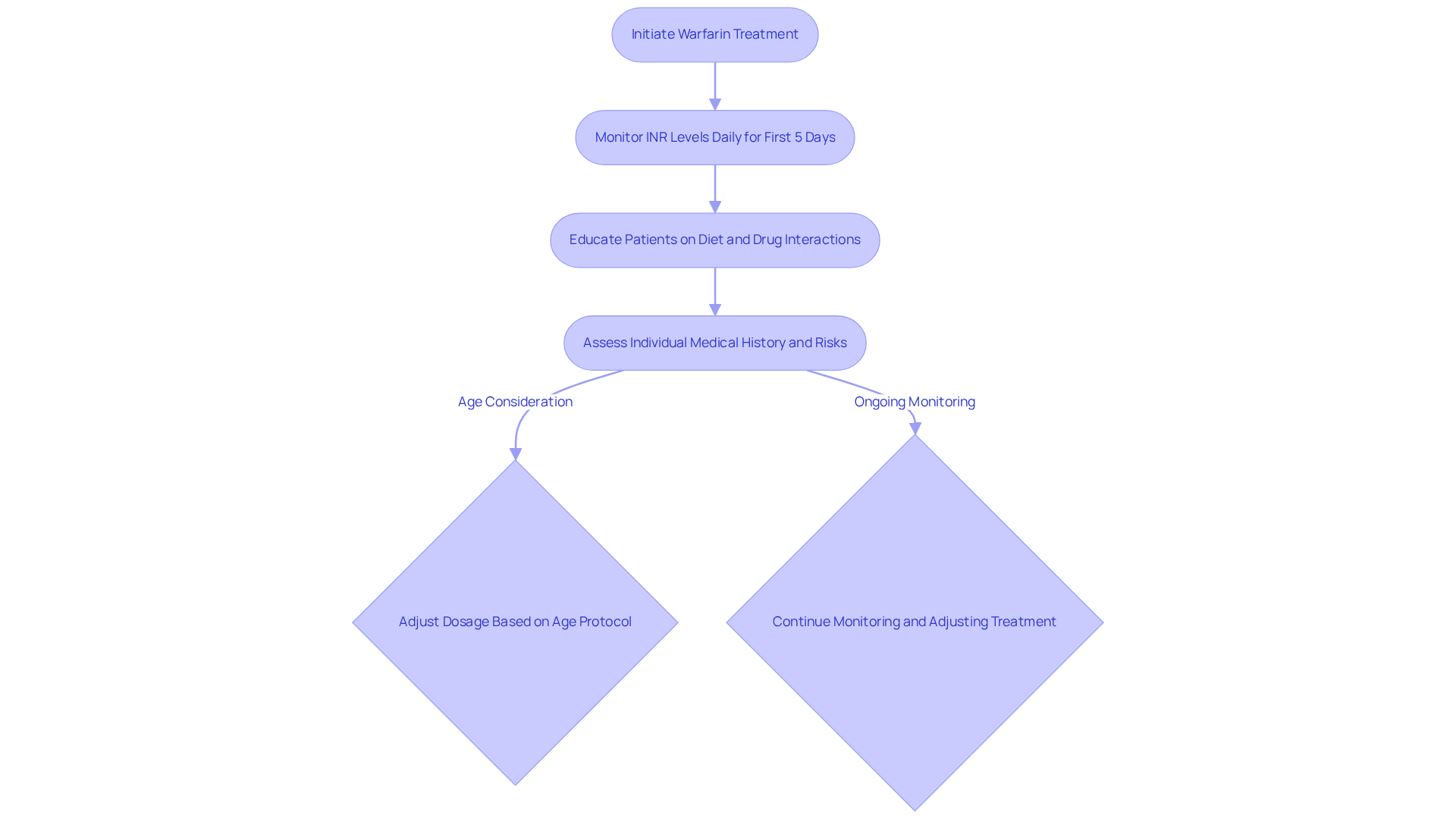
Compression stockings play a vital role in the recovery journey from DVT, offering graduated compression that enhances venous return and reduces swelling. They provide relief from symptoms and help prevent post-thrombotic syndrome, a common complication associated with DVT. It's important for patients to wear these stockings as directed, particularly during extended periods of sitting or standing, as this can significantly improve circulation and support the healing process. Notably, compression stockings with a tightness of up to 20 mmHg are available without a prescription, making them accessible options for many individuals.
Physical therapists stress the importance of consistently wearing compression stockings, as adherence can lead to more favorable outcomes. Studies indicate that individuals who follow recommended practices for using these stockings experience a substantial reduction in symptoms and complications. For example, those who regularly wear compression stockings often report enhanced comfort and improved mobility.
Real-life examples highlight the effectiveness of compression therapy. In one case study, individuals who used compression stockings after a DVT diagnosis experienced a remarkable 50% reduction in swelling and discomfort within just a few weeks. Additionally, current guidelines recommend wearing compression stockings with a tightness of 30 to 40 mmHg for optimal results, especially for those recovering from DVT. It’s also crucial to replace compression stockings every four to six months to ensure they remain effective.
Ultimately, incorporating compression stockings into DVT management not only facilitates recovery but also for individuals. This makes them an essential element of supportive care, helping patients feel more comfortable and cared for during their healing process.

Thrombolysis represents an innovative treatment option for severe cases of deep vein thrombosis (DVT), particularly when DVT meds may be necessary due to the risk of limb loss or serious complications. This procedure uses thrombolytic agents to swiftly dissolve blood clots, offering a potential lifeline for individuals who face extensive clot burdens or those who have not responded to standard anticoagulation therapies. However, it is important to understand that thrombolysis, when compared to DVT meds, comes with an increased risk of bleeding complications, occurring in about 6.7% of individuals, compared to only 2.2% for those undergoing standard anticoagulation, according to a review of 19 randomized controlled trials involving 1943 participants. This heightened risk necessitates careful selection and monitoring of patients.
Real-world outcomes suggest that thrombolysis can significantly reduce the occurrence of post-thrombotic syndrome (PTS). Studies indicate a slight decrease in PTS rates—50% in patients receiving thrombolysis versus 53% in those treated with standard methods, a finding supported by data from six trials. These results imply that thrombolysis may offer long-term benefits, particularly for older patients who are often more susceptible to complications from untreated DVT meds.
Interventional radiologists emphasize the importance of weighing the risks and benefits of thrombolysis and DVT meds in managing DVT. While this procedure can lead to than standard therapies, the potential for increased bleeding must be thoughtfully considered. As one specialist noted in the Cochrane Database of Systematic Reviews, 'Future studies are needed to explore management regimes concerning agent, dose, and supplementary clot removal methods, prioritizing patient-important outcomes, including PTS and quality of life.' This highlights the ongoing need for research to refine treatment protocols and enhance outcomes in DVT management.
If you or a loved one are facing the challenges of DVT, it is vital to discuss all available options with your healthcare provider. Understanding the nuances of treatments like thrombolysis can empower you to make informed decisions about your care.
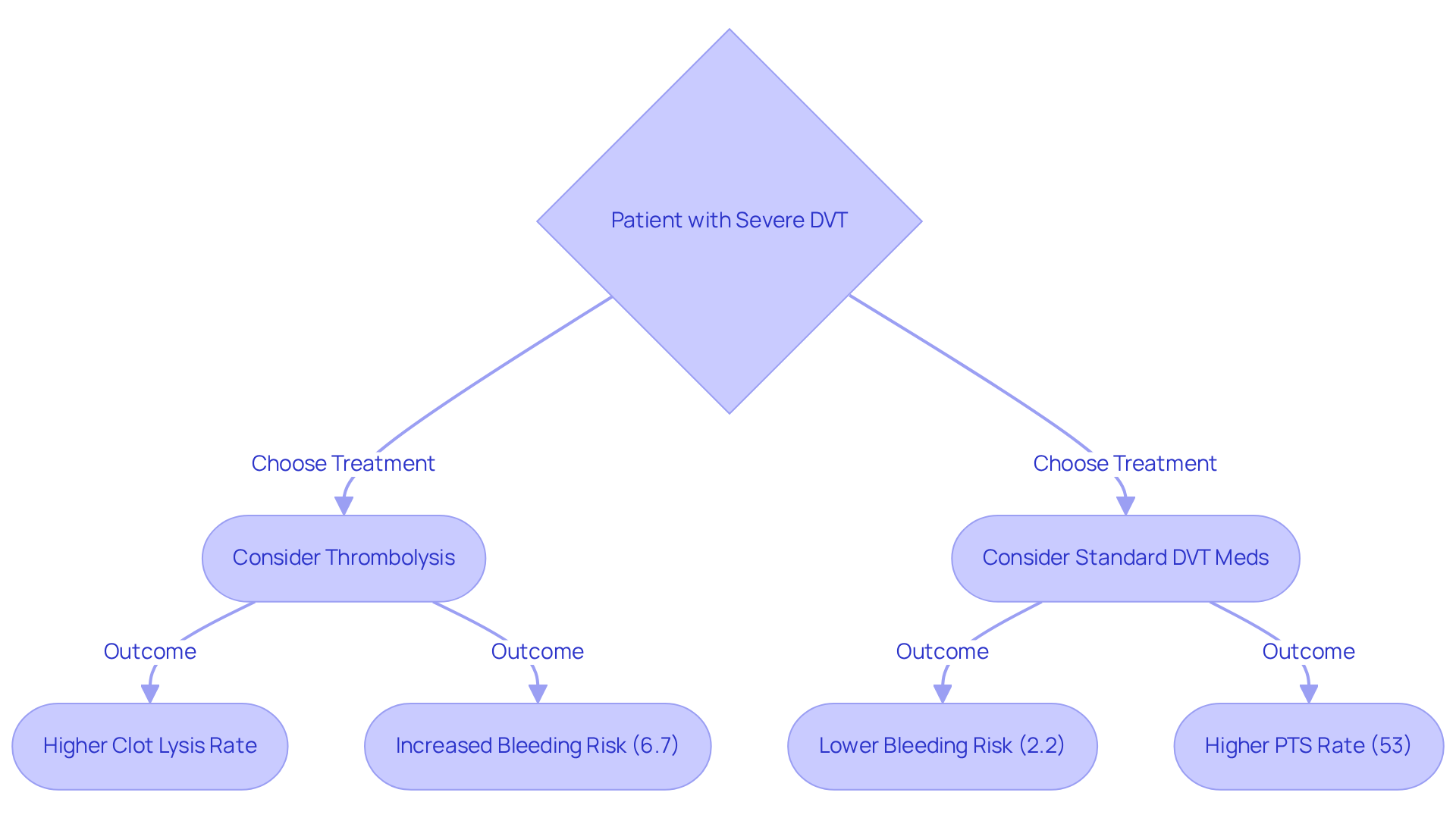
The inferior vena cava (IVC) filters are specialized instruments designed to be placed in the inferior vena cava. Their primary purpose is to prevent blood clots from reaching the lungs, thereby reducing the risk of pulmonary embolism in individuals who are treated with DVT meds for deep vein thrombosis (DVT). For those who may be unable to undergo anticoagulation treatment due to concerns about bleeding, DVT meds such as these filters can be especially beneficial.
At Amavita Heart and Vascular Health, we understand that each patient's situation is unique. The decision to use an IVC filter is made after a thorough evaluation of the individual’s condition and risk factors. This process is supported by advanced imaging capabilities and comprehensive cardiac assessments, ensuring that the benefits of the IVC filter truly outweigh any potential complications.
Our goal is to provide targeted cardiovascular care that is tailored to high-risk patients. We want you to feel confident and supported in your , knowing that you have options available to help protect your well-being.
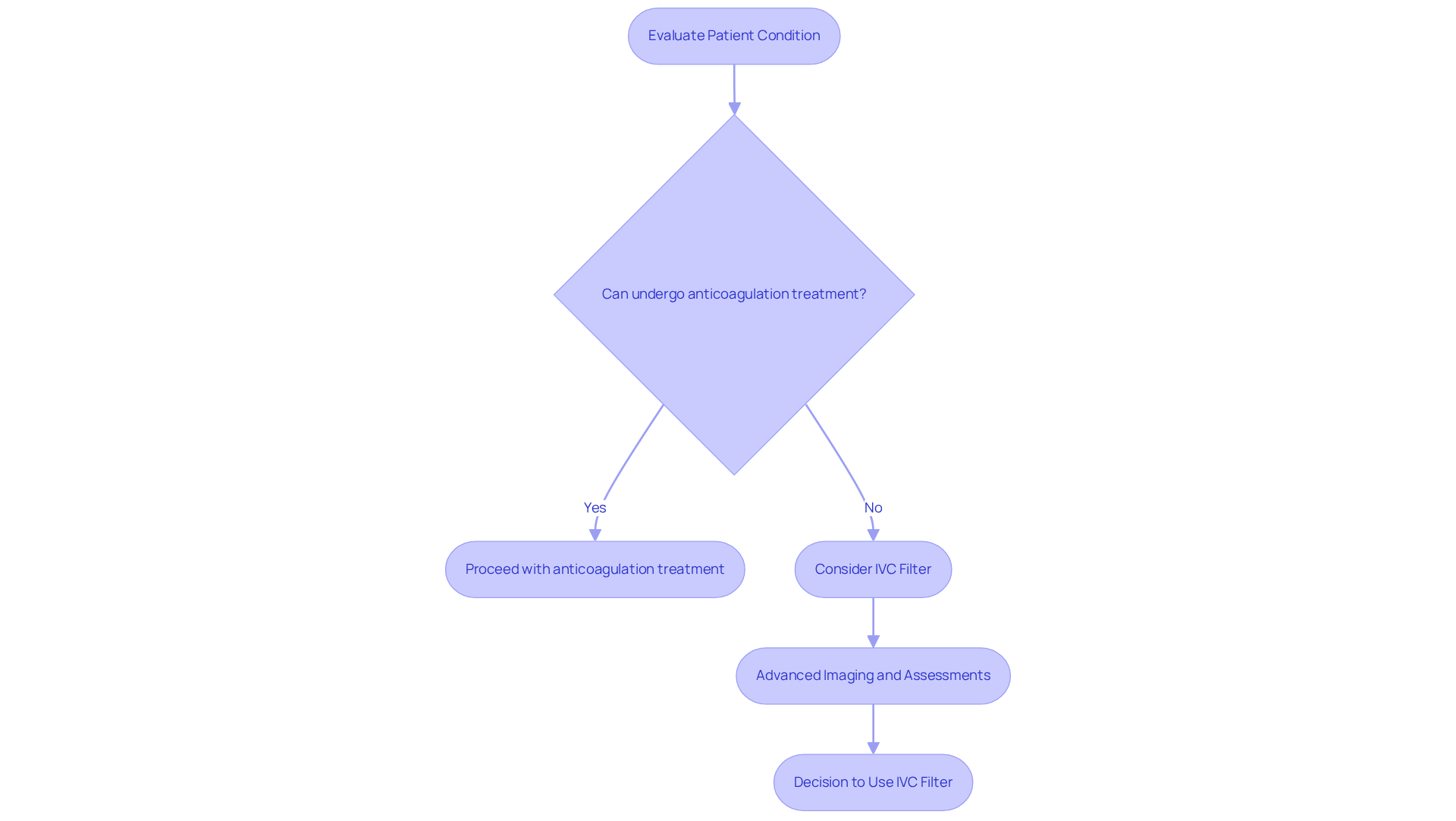
Facing Deep Vein Thrombosis (DVT) can feel overwhelming, but understanding the range of treatment options available can empower you to take charge of your health. This article has explored ten essential medications and supportive therapies that are crucial in managing DVT effectively. From well-known anticoagulants like Rivaroxaban and Apixaban to innovative procedures such as thrombolysis and the use of IVC filters, each option plays a vital role in reducing the risks associated with this condition.
Key insights highlight the importance of personalized care and education in navigating DVT management. Medications such as Dabigatran and Fondaparinux offer unique benefits and considerations, while traditional treatments like Warfarin remain relevant for specific patient needs. Additionally, supportive measures, including compression stockings, significantly enhance recovery and quality of life. It’s essential that each treatment choice is made in consultation with your healthcare provider, ensuring that your individual circumstances and preferences are taken into account.
Ultimately, the journey through DVT management is one of collaboration and informed decision-making. Engaging with healthcare professionals about the latest advancements in DVT treatment options can lead to better outcomes and improved well-being. Your commitment to comprehensive care and ongoing support is vital in fostering resilience and hope for those affected by DVT.
What is Deep Vein Thrombosis (DVT)?
Deep Vein Thrombosis (DVT) is a condition where blood clots form in the deep veins, typically in the legs, which can lead to serious complications if not treated.
What treatment options does Amavita Heart and Vascular Health offer for DVT?
Amavita Heart and Vascular Health offers a holistic approach to DVT treatment, incorporating medications, minimally invasive procedures, and personalized supportive care to improve the quality of life for patients.
How does Amavita prioritize patient education in DVT treatment?
Amavita emphasizes patient education to empower individuals to understand their treatment options and make informed health decisions, ensuring continuous support and education for long-term health and wellness.
What is Rivaroxaban and how is it used in DVT management?
Rivaroxaban is an oral anticoagulant that inhibits Factor Xa, used to manage DVT. It is favored for its once-daily dosing, which enhances adherence without the need for routine blood monitoring.
What are the benefits of using Rivaroxaban for DVT patients?
Rivaroxaban has been shown to prevent DVT recurrence effectively, with studies indicating lower rates of recurrent venous thromboembolism (VTE) in patients who continued treatment compared to those who discontinued it.
How does Apixaban differ from Rivaroxaban in treating DVT?
Apixaban is also an oral anticoagulant that inhibits Factor Xa, but it is taken twice daily. It has demonstrated superior outcomes in reducing recurrent DVT and bleeding incidents compared to Rivaroxaban.
What are the safety profiles of Rivaroxaban and Apixaban?
Both Rivaroxaban and Apixaban have favorable safety profiles, but Apixaban is noted for significantly lowering the risk of major bleeding compared to traditional anticoagulants like Warfarin.
What should patients consider when choosing between Rivaroxaban and Apixaban?
Patients should discuss their treatment options with healthcare providers to determine which medication aligns best with their health needs, considering factors such as dosing convenience and safety profiles.
What is the significance of anticoagulants in managing DVT?
Anticoagulants like Rivaroxaban and Apixaban play a vital role in managing DVT by preventing blood clot formation and recurrence, thus enhancing the quality of life for affected individuals.